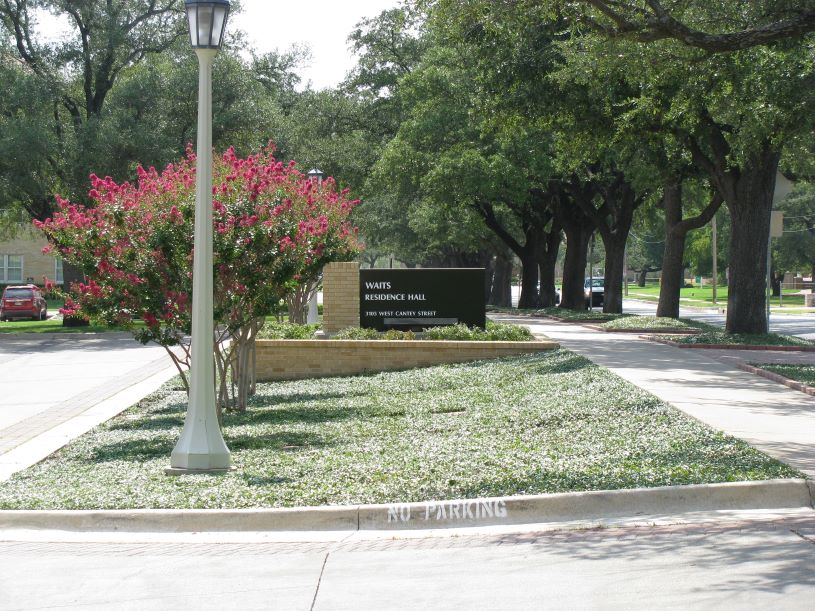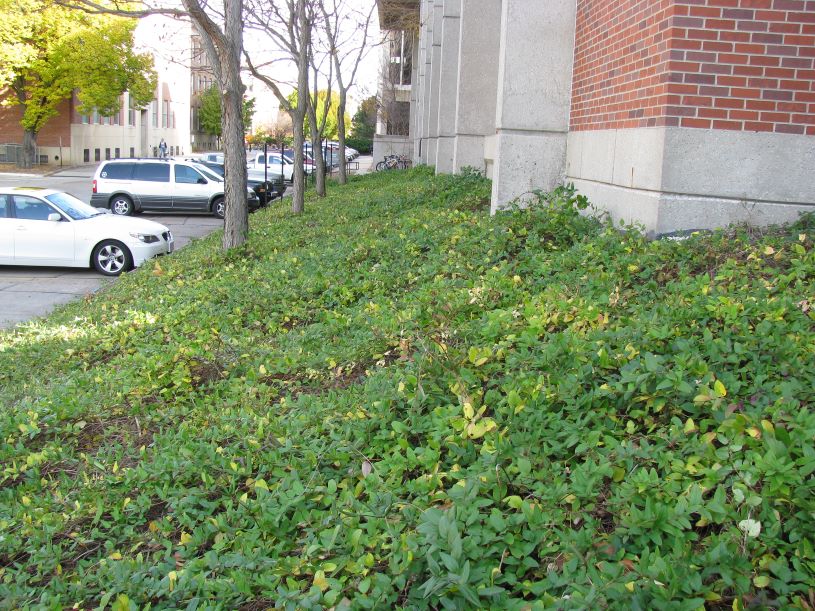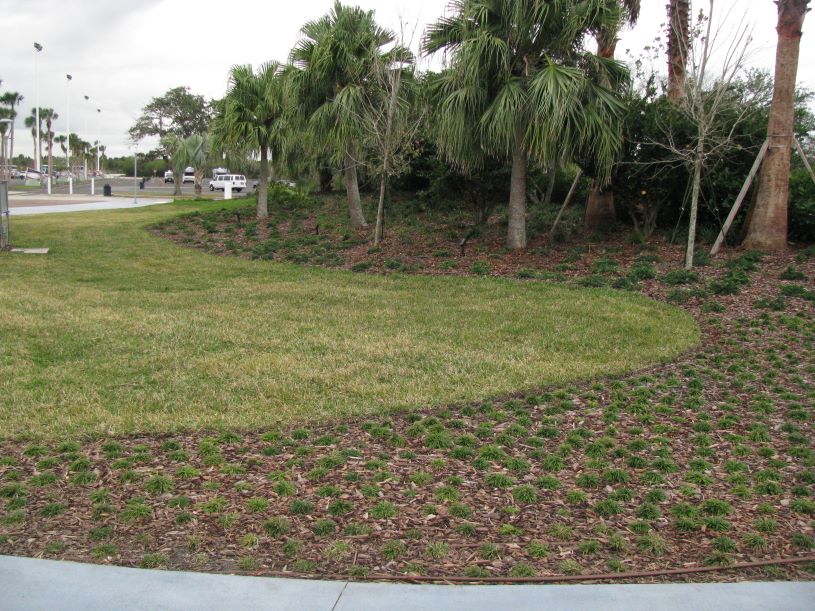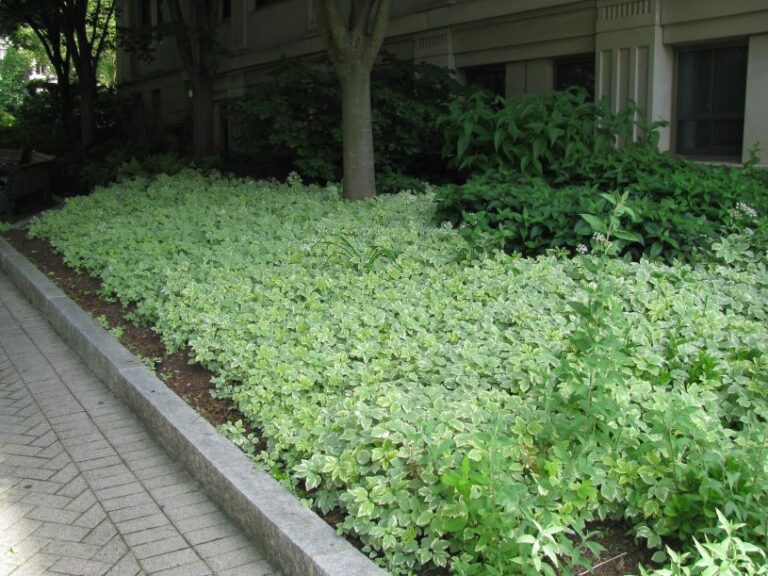By John C. Fech
On campuses, sports fields and other recreational facility grounds, turfgrass can sometimes be the default groundcover. However, in certain instances, it’s not the best choice. Locations for non-turf plants include shady sites, small spaces and heavily trafficked spots. Other considerations for replacing current plant material with groundcovers are mowing reduction, introducing texture and height variation, and the option of all-season appeal. Just like maintenance of turfgrass, considerations of pests, edging, irrigation zoning, height control and replanting are key to success.
What’s a groundcover?
For topics such as this, it’s best to start with a clear definition – what actually is a groundcover and what isn’t? In the landscapes referenced above, a groundcover is best thought of as a group of plants that is:
1. Low growing
2. Spreading
3. Isn’t routinely mowed
Each of these three parts of the definition can vary quite a bit. For example, “low growing” generally means a mature height of between 2-12 inches. Spreading can occur slowly or rapidly within a growing season, and can occur via rhizomes, stolons or seed dispersal. While groundcovers are not shorn with mowing equipment, certain plants such as Bishop’s goutweed and anemone can be cut down to an inch or so in height once or twice a year to improve their appearance. In addition, some low-growing shrubs such as cranberry cotoneaster can take on the appearance and function of a groundcover if they are closely spaced. Although there are exceptions to these guidelines, the three “qualifiers” remain.
Just the name “groundcovers” begs the questions “Where?” and “Why?” There is certainly also the general feel or sense of place that a groundcover emits – low plants that hug the ground and fill in spaces between other plants. The question of “Where?” is answered by “Anywhere” – sun, shade, slopes, in the open, under other plants, in front of a bed, surrounding trees/shrubs, among pavers, and next to fencing. “Why?” is a consideration of the many benefits of groundcovers.

Benefits of groundcovers
Groundcovers fit squarely with the tried-and-true principle of Right Plant, Right Place (RPRP), adding a multitude of options for attractive and functional green plants in the landscape. Perhaps the most classic usage is to install them where turfgrass isn’t a good option due to low light levels and/or a prohibitive degree of slope for mowing. Since even the most shade-tolerant of mowed turfgrasses require a minimum of three to four hours of sunlight per day, they simply don’t qualify for shady sites in an RPRP sense. Likewise, with the safety of the operator in mind, severe slopes that don’t have to be mowed are a plus in the landscape. Erosion is greatly reduced on slopes that are covered with a vigorous, well-sited groundcover as compared to worn, heavily compacted and poorly performing turf.
A hallmark of a groundcover is that it has the capacity to add texture, leaf shape and color differences to the landscape. Enhanced textural appeal is created when round and oval leaves are placed next to the lance-shaped upright blades of turfgrass or placed between upright shrubs as filler plants. Of course, since color is one of the most powerful landscaping influences, the potential to introduce complementary or contrasting hues with another low-height ornamental mass in lieu of turf is a real plus. Groundcovers embody the technique of massing, the pulling together of like-sized, shaped and colored plant material, which gives the overall landscape a sense of unity and the opportunity to repeat similar elements throughout.

Pitfalls of groundcovers
Unfortunately, the road to effective groundcover use is not paved with gold, as using them is not a push-the-easy-button endeavor. First, by definition, groundcovers spread; some species are more aggressive lateral growers than others, and creep into nearby turf or other groundcover areas. This tendency usually requires the use of herbicides and hand labor to keep the ones that aren’t “well behaved” in line. Weed control in a groundcover bed can be difficult, especially during establishment. There are a few preemergence herbicides that can be utilized; however, hand pulling and hoeing is usually necessary at least to some degree.
Since groundcovers can’t read the same books that we do, they don’t always grow to the expected height, thus creating a need to prune, cut or control height in some cases. A degree of flexibility in expectations goes a long way when managing groundcovers. In addition to height issues, there is the need to control insects and diseases. Getting to know each species, and scouting for various pests will prevent damage in most cases. Also, just like all plants, groundcovers die and need to be replaced. Adding the cost of replanting into the budget is prudent with groundcovers, as well as other plants in the landscape.
Installing groundcovers
Planting groundcovers is much the same as most other ornamental plants except for one big difference – groundcovers spread and grow laterally. In fact, the sideways movement should be taken into account both initially and long-term. Though most will fill in the space eventually, a 9- or 12-inch spacing is the sweet spot for most species. Sure, there is money to be saved with an 18-inch center spacing, but the users and owners of the property being managed tend to get a little impatient if they see too much non-plant surface. On the other side of things, a 4- to 6-inch spacing will allow plants to fill in more quickly, but require a lot more budget to get it done.
Groundcovers will establish well if the soil is loosened and amended before planting. A 4-pronged pitchfork is a good tool for this purpose as it breaks the surface crust without destroying soil structure.
Testing the soil beforehand is always a good idea, with a keen eye on pH, organic matter content, cation exchange capacity, salinity and micronutrients. Deficiencies in these categories are best corrected before the plants are stuck in the ground. Loosening is also important for the roots of the plant as well. If they are tangled in the cell pack or pot, take a couple of minutes to simply pull them apart – much like you would before eating a cinnamon roll – to prevent them from continuing to encircle and limit water/nutrient movement in the plant.
Once plants are installed, it’s important to keep them moist, not soggy or dry (at least for most species). Consider the instructions on the plant care tags for groundcovers that prefer “dry shade” and “hot and sunny” conditions. A simple screwdriver test routine will serve well in the days after planting. The force required to push a screwdriver into the soil is very telling; very little is required if the soil is moist, lots is needed if the soil is dry. In addition to how hard you need to push, feeling the blade after it is pulled out is a good indicator as well. If the blade is muddy, the soil and roots are moist and no watering is required; if it’s powdery dry, then it’s time to water.
Death and taxes are two things you can count on; but as a sports field or grounds manager, one more thing needs to be added to that list – weeds. Weeds are inevitable, and, depending on the seed bank, can be overwhelming. The two biggest tools to control them are mulch and preemergence herbicides. Organic mulches such as pine straw, wood chips, stump grindings and cottonseed hulls are great for suppressing weed growth, holding in moisture, and keeping roots cooler than the air temperature. Applying a preemergence herbicide before the mulch is a key step as well. As with all pesticides, it’s crucial to take the time to read and follow the label instructions, especially with groundcovers, as some species are sensitive to damage and will be injured.

Using groundcovers effectively
Effective use of groundcovers in the landscape starts with a thorough site assessment, where specific needs for various sites are identified. The pitfalls and benefits of these plants should be thoroughly considered; writing them out beforehand and discussing them with the crew members often helps communicate the eventual work activities that will be necessary to manage them well. After establishment, a second look or follow-up evaluation will provide helpful information on how well they have performed on site, and point out any adjustments that should be made for future plantings. Gaining the opinion of a local Extension horticulturist with a nearby land grant university as the process is implemented will prove to be beneficial as well.
John C. Fech is a horticulturist with the University of Nebraska-Lincoln and Certified Arborist with the International Society of Arboriculture. The author of two books and more than 400 popular and trade journal articles, he focuses his time on teaching effective landscape maintenance techniques, water conservation, diagnosing turf and ornamental problems, and encouraging effective bilingual communication in the green industry.


